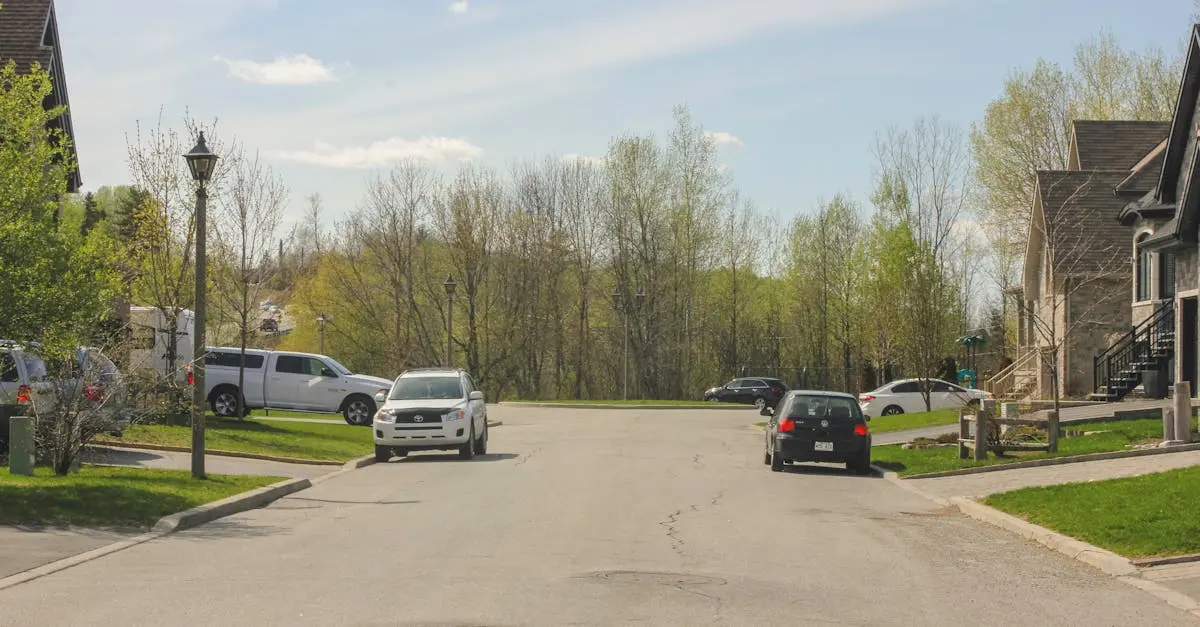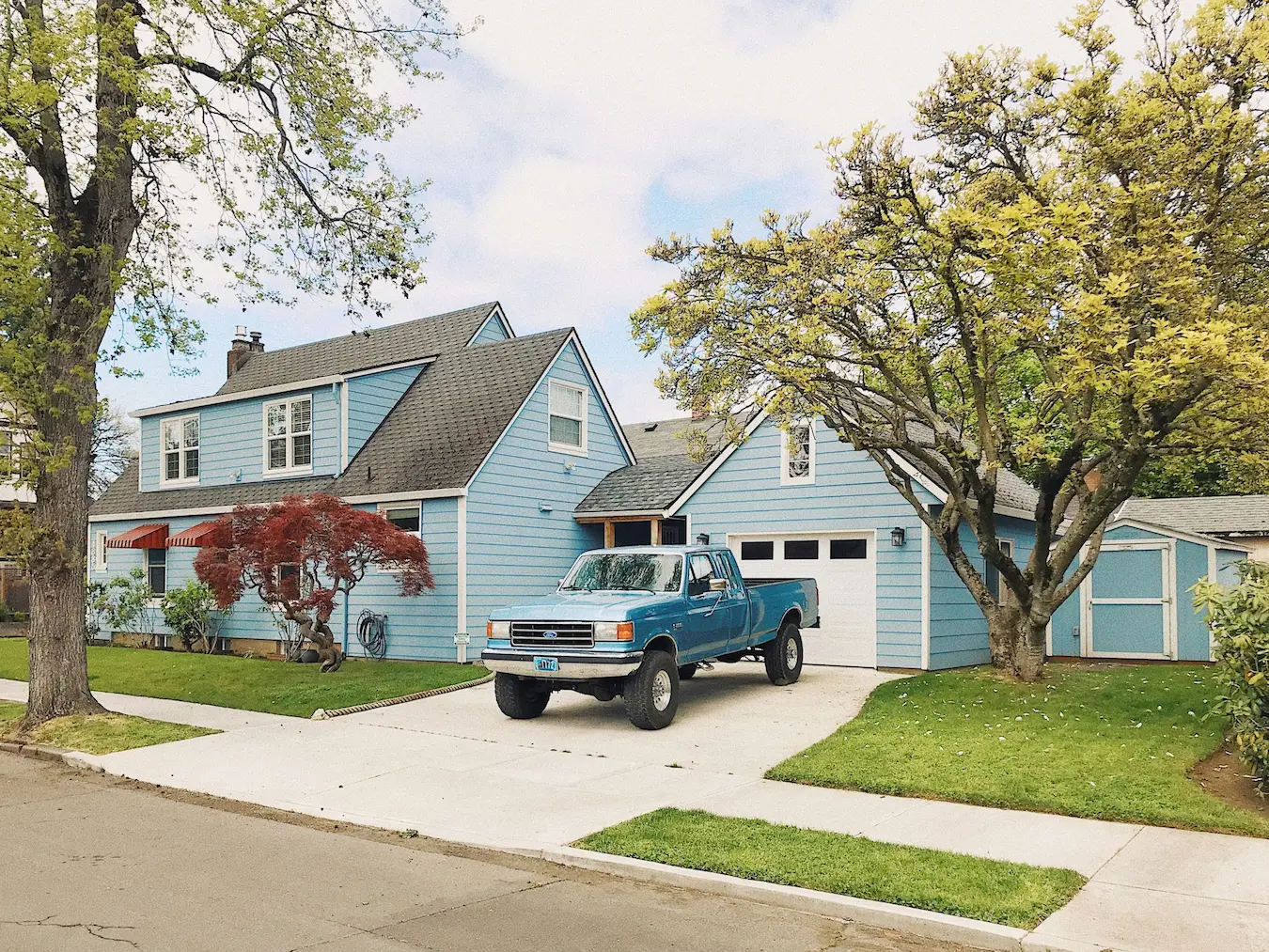Introducing Curvspace Driveways
Curvspace Driveways enhance curb appeal with flowing lines and layouts that break the monotony of traditional designs. At Curvspace, we inspire you to transform threshold spaces into attractive, functional areas using high-quality materials like concrete, brick, cobblestone, and permeable pavers. These materials ensure both durability and aesthetic appeal. Customization options include personalized patterns, colors, textures, decorative borders, and lighting. Permeable pavers not only offer excellent drainage, reducing runoff and environmental impact, but also enhance property value. Proper maintenance ensures longevity, making driveways a sought-after feature that reinforces the importance of quality design in elevating a property’s overall aesthetic.
Reader Disclosure
Jump to:
What is a Driveway?
A driveway is a private road that connects a house or garage to the public street. Driveways are designed to provide safe and convenient access for vehicles. Typically, these pathways involve materials like concrete, asphalt, gravel, or pavers. Each material has its pros and cons, affecting longevity, cost, and maintenance.
Certain driveways also serve as aesthetic features of a property. They enhance curb appeal, complementing the architectural style and landscaping. Well-planned driveways add functionality by providing parking spaces and ease of access.
Residential driveways come in various layouts and sizes. Some are simple straight paths, while others might feature slopes or decorative elements.
Homeowners often invest in high-quality driveways. This investment boosts property value and adds visual appeal. Popular styles include U-shaped, circular, and straight driveways. Modern designs prioritize both functionality and aesthetics.
Environmental considerations are also relevant. Permeable driveway materials help manage water runoff and reduce environmental impact. Driveways should match local regulations and homeowner needs for optimal functionality and sustainability.
The History of Driveways
The concept of driveways dates back to ancient civilizations. These early pathways connected homes in Mesopotamia and Roman Empire estates to main roads.
In the 19th century, driveways in urban areas became more common. Wealthy homeowners created private carriage paths to access their grand houses. These driveways, often made from cobblestones or gravel, showcased the owners’ status.
The 20th century saw a shift in driveway materials. As automobile use increased, concrete and asphalt became the preferred choices. These materials offered durability and ease of maintenance. Suburban development in the mid-1900s further popularized driveways, as families needed parking spaces for multiple vehicles.
Driveway design has evolved to meet modern needs. Aesthetic appeal, environmental concerns, and technological advancements now influence material choices and layouts. Offering a blend of tradition and innovation, today’s driveways serve both functional and decorative purposes.
Purpose of Driveways
Driveways enhance a home’s curb appeal while providing safe vehicle access to public streets. They increase property value by offering a structured space for parking and easy transportation.
Driveways serve as private roads connecting homes to the main streets, ensuring vehicles have a dedicated path. They reduce risk by clearly defining vehicle paths and minimizing conflicts with pedestrian areas.
In addition to functionality, driveways contribute to a home’s aesthetics. Various materials like concrete, asphalt, gravel, and pavers offer diverse design options to complement different architectural styles. Customizable layouts such as U-shaped, circular, and straight designs add unique character to the property.
Environmental benefits come into play with permeable materials. These materials help manage water runoff, reducing pollution and promoting sustainability.
Driveways merge functional utility with aesthetic appeal, enhancing overall property value and ensuring safer vehicular access.
Types of Driveways
Concrete Driveways
Concrete driveways offer durability and long lifespan. They’re low maintenance and can handle heavy loads, making them ideal for homes with larger vehicles. Stamped concrete adds aesthetic value by mimicking other materials like brick or stone. Installation costs average $4,000-$10,000 depending on size and design.
Asphalt Driveways
Asphalt driveways are cost-effective and quick to install, usually within a day. They perform well in cold climates, where freeze-thaw cycles can damage other materials. Regular sealing, typically every 3-5 years, extends their lifespan. Initial installation costs range from $2,000-$6,000.
Gravel Driveways
Gravel driveways provide affordability and easy maintenance. Suitable for longer driveways due to lower installation costs, gravel surfaces offer excellent drainage, reducing water runoff issues. Expect to pay between $1,500-$4,000, with periodic regrading and replenishing costs.
Paver Driveways
Paver driveways stand out through their customizable design options. Interlocking pavers come in various shapes, colors, and materials such as brick, concrete, and stone. They perform well under heavy loads and can be individually replaced if damaged. Installation costs are higher, typically $5,000-$15,000.
Cobblestone Driveways
Cobblestone driveways offer high durability and a distinct aesthetic. Cobblestone, though more expensive, stands the test of time and requires minimal maintenance. Installation costs range from $10,000-$20,000 but provide an old-world charm and long-term value.
Permeable Driveways
Permeable driveways manage water runoff effectively by allowing water to seep through the surface. Options include permeable pavers, gravel, and porous concrete. Installation usually costs between $5,000-$10,000, promoting eco-friendliness and reducing the risk of flooding.
Resin-Bound Driveways
Resin-bound driveways combine visual appeal and practicality. The mixture of aggregate stones and resin creates a smooth, hard-wearing surface. Resistant to cracking and requiring minimal maintenance, these driveways typically cost between $4,000-$9,000.
Brick Driveways
Brick driveways bring classic charm and substantial durability. Bricks, although susceptible to cracking in extreme cold, offer easy replacement. Installation costs range from $7,000-$12,000, with properly maintained brick surfaces lasting decades.
Contemporary Uses of Driveways
Driveways function as more than just vehicle pathways. Outdoor spaces become multipurpose assets when driveways integrate modern uses and designs. Here’s how contemporary driveways enhance functionality and aesthetics.
Extra Parking Space
Driveways often double as extra parking spaces for guests. Expanded areas can accommodate additional cars, reducing street clutter. Use concrete, pavers, or cobblestones for durable, visually appealing surfaces.
Recreational Areas
Many homeowners utilize driveways as recreational areas. Children ride bikes, adults set up temporary sports courts, and families gather for barbecues. Durable materials like asphalt and concrete withstand such activities well.
Aesthetic Enhancements
Modern driveways significantly boost curb appeal. Symmetrical designs, color contrasts, and material blends contribute to the overall aesthetics. Stamped concrete, custom pavers, and resin-bound surfaces offer numerous creative possibilities.
Safety and Security
Illuminated driveways enhance safety and security. Solar-powered lights or integrated led fixtures both illuminate pathways and deter intruders. Wide driveways with clear visibility also reduce accident risks.
Sustainable Practices
Environmentally conscious homeowners choose permeable materials. Driveways made with permeable pavers improve water drainage, decreasing runoff and promoting groundwater recharge. Permeable options include permeable concrete, gravel, and grass grids.
Event Hosting
An extended driveway serves as a venue for small gatherings. Couples can host outdoor parties and community meetings. Ample, clean space allows for seating arrangements and decorations. Materials like pavers and brick not only add flair but also withstand high foot traffic.
Utility Zones
Driveways provide space for temporary utility zones. Delivery trucks, garbage collectors, or home service providers utilize driveways efficiently. Well-constructed driveways handle the weight and movement of heavy vehicles.
Playgrounds
For parents with young children, driveways turn into playgrounds. Safety features like smooth surfaces, bounded edges, and non-slip coatings improve the play area. Asphalt or resin-bound surfaces offer practical options for child-friendly spaces.
Car Wash Stations
Homeowners use driveways as car wash stations. Water-resistant materials make cleaning easy and prevent damage. Concrete and resin-bound surfaces provide solid, water-tolerant options.
Gardening Projects
Some driveways incorporate garden plots or container gardens around the edges. Plants, flowers, and herbs add beauty and greenery to the property. Landscaping integrates well with driveways made from pavers or brick.

Modern Trends in Driveway Design
Eco-Friendly Materials
Using eco-friendly materials in driveway design has become popular. Permeable pavers, recycled asphalt, and grass pavers (e.g., Turfstone) are excellent choices. These materials reduce runoff, mitigate flooding, and contribute to groundwater recharge.
Geometric Patterns
Geometric patterns in driveway designs add a contemporary look. Opt for hexagonal, chevron, or herringbone layouts to achieve a unique style. These layouts enhance visual appeal and create a modern ambiance.
Lighting Integration
Driveway lighting improves safety and aesthetics. LED pathway lights, in-ground lights, and wall-mounted fixtures illuminate the driveway. Choose energy-efficient lighting options to reduce energy consumption.
Heated Driveways
Heated driveways prevent snow and ice buildup. Install a radiant heating system beneath the surface to keep the driveway clear during winter. This feature adds convenience and reduces the need for manual snow removal.
Mixed Materials
Combining materials offers a distinctive appearance. Mix concrete and gravel, pavers and grass, or asphalt and bricks to create contrast and depth. These combinations enhance the driveway’s aesthetic value and functionality.
Smart Technology
Integrating smart technology adds convenience to driveway design. Use smartphone apps to control driveway gates or lights remotely. Install motion sensors for automatic lighting that activates upon entry.
Artistic Inlays
Artistic inlays personalize driveway designs. Incorporate mosaic tiles, stone patterns, or custom engravings. These inlays showcase individual style and create a striking focal point.
Green Driveways
Green driveways incorporate grass or ground cover between pavers. These designs promote sustainability and blend seamlessly with landscaping. Use drought-resistant grass to reduce water usage.
Resin-Bound Gravel
Resin-bound gravel driveways offer durability and aesthetic appeal. The resin-bound system creates a smooth, permeable surface that withstands heavy traffic. Choose various colors and aggregate types for customization.
These modern trends in driveway design reflect the evolving requirements of homeowners seeking functionality, style, and sustainability in their outdoor spaces.
Cultural Diversity in Driveway Design
Driveways reflect cultural influences that shape their aesthetics and functionality. In the United States, you’ll often see concrete or asphalt driveways. These materials are practical for the country’s diverse climates. For example, concrete withstands the hot summers in the southern states, while asphalt’s flexibility suits the northern regions with freeze-thaw cycles.
In Europe, cobblestone and paver driveways dominate. These materials offer durability and historical resonance. Traditional cobblestone driveways are common in older cities, reflecting centuries-old practices. Modern pavers, while contemporary, still echo that classic charm.
Asian driveway designs often incorporate minimalist elements. In Japan, gravel driveways surrounded by lush greenery exemplify Zen principles, emphasizing simplicity and serenity. In contrast, Chinese driveway layouts might involve intricate stonework and symmetrical designs, reflecting feng shui principles and cultural heritage.
In Latin America, vibrant designs and colors characterize many driveways. Mexican homes might feature driveways with bright tiles and mosaic patterns, expressing the region’s artistic spirit. Brazilian driveways may include natural stone and lush landscaping, blending functionality with tropical aesthetics.
African driveway designs vary greatly across the continent. In North Africa, Moroccan influence brings ornate tilework and mosaic patterns to driveways, often integrated with lush gardens. In sub-Saharan Africa, gravel and natural stone driveways are common, highlighting a connection to the surrounding natural environment.
Cultural diversity manifests in driveway design through distinct materials, layouts, and aesthetics shaped by regional practices and environmental factors. Each style tells a unique story, contributing to the global tapestry of driveway design.
Curvspace Qualities of Driveways
Curvspace qualities impact driveway aesthetics and functionality. Driveways designs can add visual interest compared to straight layouts. Properly planned driveways can create a welcoming entrance and guide vehicles smoothly.
Enhancing Aesthetics
Driveways enhance curb appeal and smooth create a flow that complements landscaping elements (e.g., flower beds, trees). Unique shapes and curves can highlight the architectural features of homes and buildings.
Improved Maneuverability
Drivers find it easier to navigate gentle bends rather than sharp turns. Driveways designs provide more space for parking and turning.
Practical Considerations
Consider slope and material when designing driveways. Gentle slopes ensure water drains properly, preventing puddling. Common materials include concrete, asphalt, and pavers, each offering different levels of flexibility for curved layouts. For instance, pavers can be adjusted individually, fitting seamlessly.
Environmental Benefits
Driveways can be eco-friendly. They often reduce the amount of impervious surface area, promoting natural water infiltration. This contributes to better groundwater recharge and less soil erosion. Green driveways (e.g., permeable pavers) merge well with curvspace designs.
Cultural Influences
Cultural influences shape driveway trends. European designs often feature gentle, sweeping curves reminiscent of historic pathways. Asian driveways may incorporate winding shapes, mirroring natural landscapes in garden philosophies. North American trends integrate practical designs that align with modern suburban layouts.
Driveways offer numerous benefits, from aesthetic appeal to improved functionality. By considering material choice, slope, and cultural influences, driveways can enhance both residential and commercial spaces while promoting sustainability.
People Also Ask
What are some common materials used for driveways?
Common driveway materials include concrete, asphalt, gravel, pavers, cobblestone, permeable pavers, resin-bound surfaces, and brick. Each material offers unique benefits and aesthetic options.
What is the cost range for different driveway materials?
Costs vary depending on the material. Concrete ranges from $4 to $10 per square foot, asphalt $2 to $5, gravel $1 to $3, pavers $10 to $50, and permeable options generally start around $10 per square foot.
How can a driveway enhance a home’s curb appeal?
A well-designed driveway can boost curb appeal by adding visual interest, complementing the home’s architecture, and improving overall property aesthetics.
What are permeable driveways?
Permeable driveways use materials like permeable pavers or recycled asphalt that allow water to filter through, helping reduce runoff and promote environmental sustainability.
How are modern driveways being used beyond parking?
Contemporary uses include serving as recreational spaces, hosting events, creating utility zones, functioning as playgrounds, and incorporating gardening projects.
What are current trends in driveway design?
Trends include eco-friendly materials, geometric patterns, integrated lighting, heated surfaces, mixed materials, smart technology, artistic inlays, and green driveways.
How does cultural diversity influence driveway design?
Cultural diversity affects materials, layouts, and aesthetics. For example, cobblestones are popular in Europe, while gravel is frequent in the US. Asia often uses intricately designed inlays, and eco-friendly options are trending worldwide.
Conclusion
At Curvspace, we view driveways as more than just functional spaces—they’re key to a home’s overall appeal and utility. With a wide range of innovative materials and creative designs available, the options for driveways are both vast and varied. Modern trends and global influences continue to shape how we perceive and utilize these spaces. By incorporating the latest advancements and cultural inspirations, you can create driveways that are not only practical but also stylish and sustainable. Whether you’re looking to enhance curb appeal, add extra functionality, or embrace eco-friendly practices, Curvspace inspires you to transform these threshold spaces into essential elements of your property’s charm and functionality.
Show & Tell
We’d love to hear your thoughts about these ideas! Simply click the link to head over to your favorite platform and add your comments about this post there. We’d like to know about your insights, questions, or just saying hi.
More Curvspace Topic Pages
Disclosure
Our content is reader-supported. This means if you click on some of our links, then we may earn a commission. Commissions do not affect our editor’s opinions or evaluations. Learn more about our editorial process.

About the Editorial Staff
The Curvspace editorial team comprises a diverse group of experts on intermediate and threshold spaces in homes and workplaces. Architects and interior designers, civil engineers and artists, environmental and behavioral psychologists, sociologists and anthropologists. All collaborate to create helpful content, that explores the full potential of these often-overlooked areas to enhance our daily lives.


